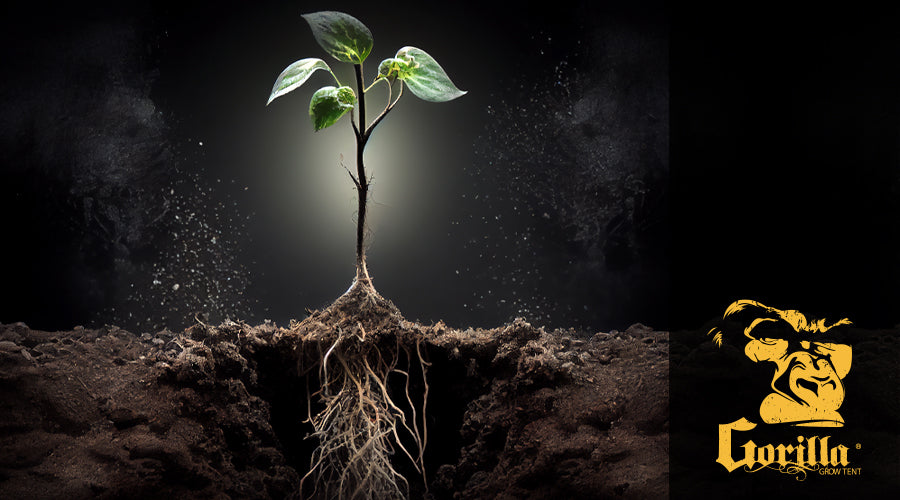
How Do Plants Get Nutrients?
With this article, we wanted to inform you briefly about how plants are fed. You will find the basic information about plant nutrition that you need when stepping into cultivation.

Rooting for Nutrients: How Plants Absorb Essential Nutrients from Soil
Plants obtain nutrients primarily from the soil through their roots. A plant's roots have tiny hair-like structures called "root hairs" that absorb water and dissolved nutrients from the soil.
Nutrients that plants need include macronutrients such as nitrogen, phosphorus, and potassium and micronutrients such as iron, zinc, and manganese. These nutrients are dissolved in soil water and taken up by the roots.
After nutrients are absorbed by the roots, they are transported throughout the plant via xylem and phloem. The xylem is responsible for the transport of water and minerals from the roots to the leaves, while the phloem is responsible for the transport of sugars and other organic compounds from the leaves to the rest of the plant.
Photosynthesis and Beyond: A Guide to How Plants Get Their Nutrients
Plants also produce their own food through photosynthesis, which involves the use of sunlight, water, and carbon dioxide to create glucose and oxygen. This process takes place in the leaves of the plant, and the glucose produced is used as fuel for plant growth and other metabolic processes.
In some cases, plants may also obtain nutrients from other sources, such as the decomposition of organic matter or symbiotic relationships with other organisms, such as nitrogen-fixing bacteria.
Plants also have the ability to adjust their nutrient intake to suit their needs. For example, if a plant is nitrogen deprived, it can increase the number of root hairs to absorb more nitrogen from the soil. Similarly, if a plant is getting too much of a particular nutrient, it can reduce the number of root hairs that absorb that nutrient.
The Role of Environmental Factors in Nutrient Uptake in Plants
In addition to soil nutrients, plants also need certain environmental conditions to thrive. For example, they need adequate light, water, and warmth for optimum growth. When these conditions are not met, the plant may have difficulty in the uptake of nutrients even if it is in the soil.
Tomato Plant Nutrients
Tomato plants are popular with home gardeners because of their delicious fruit and easy growth. However, like all plants, they need certain nutrients to thrive.
In this article, we will look at the essential nutrients that the tomato plant needs and how to ensure that they get them.
The Role of Nitrogen, Phosphorus, and Potassium in Tomato Plant Growth
Nitrogen:
Nitrogen is an essential nutrient for plant growth and is necessary for the development of leaves, stems, and branches. It also plays an important role in the production of chlorophyll, which is essential for photosynthesis. Nitrogen deficiency can cause stunted growth and yellowing of leaves. You can use compost, manure, or organic fertilizers such as blood meal to ensure your tomato plants get enough nitrogen.
Phosphorus:
Phosphorus is essential for root development, fruit production, and overall plant growth. It also plays a role in photosynthesis and energy transfer within the plant. Phosphorus deficiency can cause stunted growth, poor fruit development, and purple leaves. You can ensure that your tomato plants get enough phosphorus by using organic fertilizers such as bone meal, rock phosphate, or fish emulsion.
Potassium:
Potassium is essential for regulating water movement in the plant and is essential for fruit development, disease resistance, and overall plant health. Potassium deficiency can cause weak stems, poor fruit development, and yellowing leaves. You can ensure that your tomato plants get enough potassium by using organic fertilizers such as wood ash, seaweed meal, or banana peel.
The Essential Nutrients Your Tomato Plants Need to Thrive
Calcium:
Calcium is necessary for strong cell walls and general plant structure. It also plays a role in preventing blossom end rot, a common disease that affects tomato plants. Calcium deficiency can cause stunted growth, wilted leaves, and rot of flower tips. You can use organic fertilizers such as gypsum or bone meal to ensure your tomato plants get enough calcium.
Magnesium:
Magnesium is essential for the production of chlorophyll, which is essential for photosynthesis. It also plays a role in energy transfer within the plant. Magnesium deficiency can cause the yellowing of leaves and poor fruit development. You can use organic fertilizers such as Epsom salt or dolomite lime to ensure your tomato plants get enough magnesium.
In addition to these essential nutrients, tomato plants also need micronutrients such as iron, zinc, and manganese, which are required in smaller amounts. You can ensure that your tomato plants receive these micronutrients by using organic fertilizers or foliar sprays.
It's important to note that an excess of any nutrient can harm your tomato plants. Over-fertilization can cause nutrient burn, which can damage or kill the plant. Always follow the directions on the fertilizer package, and remember to monitor your plants for signs of over-fertilizing.

Lena Myles
I'm a mushroom enthusiast and home cook based in Oregon. I'm passionate about foraging and creating fungi-focused recipes, especially delicious, plant-based dishes using gourmet mushrooms like trumpet, shiitake, and oyster. When I’m not in the kitchen, you’ll usually find me wandering the woods in search of new wild flavors.


